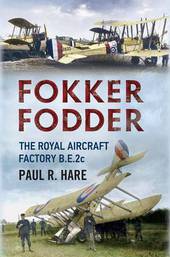
|
Fokker Fodder: The Royal Aircraft Factory B.E.2c
Hardback
Main Details
| Title |
Fokker Fodder: The Royal Aircraft Factory B.E.2c
|
| Authors and Contributors |
By (author) Paul R. Hare
|
| Physical Properties |
|
| Category/Genre | British and Irish History
First world war |
|---|
| ISBN/Barcode |
9781781550656
|
| Classifications | Dewey:623.7464 |
|---|
| Audience | |
|---|
|
Publishing Details |
| Publisher |
Fonthill Media Ltd
|
| Imprint |
Fonthill Media Ltd
|
| Publication Date |
15 November 2012 |
| Publication Country |
United Kingdom
|
Description
Designed as the benchmark against which competitors in the 1912 Military Aeroplane Competition were judged, the B.E.2 outperformed them all and was put into production becoming the most numerous single type in Royal Flying Corps service. The B.E.2c, a later variant, was designed to be inherently stable and was nicknamed the 'Quirk' by its pilots. Intended mainly for reconnaissance, it was hopelessly outclassed by the Fokker Eindecker fighter and its defenceless crews quickly became known as 'Fokker Fodder'. The Eindecker, piloted by top scoring German aces such as Max Immelmann and Oswald Boelcke, made short work of the B.E.2c in the aerial bloodbath coined as the 'Fokker scourge'. Its vulnerability to fighter attack became plain back home and to the enemy who nicknamed the B.E.2c as kaltes fleisch or cold meat. British ace Albert Ball said that it was a 'bloody terrible aeroplane'. B.E.2c crews were butchered in increasing numbers. The B.E.2c slogged on throughout the war, and its poor performance against German fighters, and the failure to improve or replace it, caused great controversy in Britain. One MP attacked the B.E.2c and the Royal Aircraft Factory in the House of Commons stating that RFC pilots were being 'murdered than killed. ' This resulted in a judicial enquiry that cleared the factory and partly instrumental in bringing about the creation of the Royal Air Force.
Author Biography
PAUL R. HARE has made a lifelong study of early aviation with particular emphasis on the Royal Aircraft Factory at Farnborough and, in addition to writing books and articles, have lectured on the topic to numerous organisations both in England and the USA. Hare has been involved, at director level, with several aeroplane museums and, as a leading authority on the subject, have acted as technical advisor on a number of restoration projects.
|